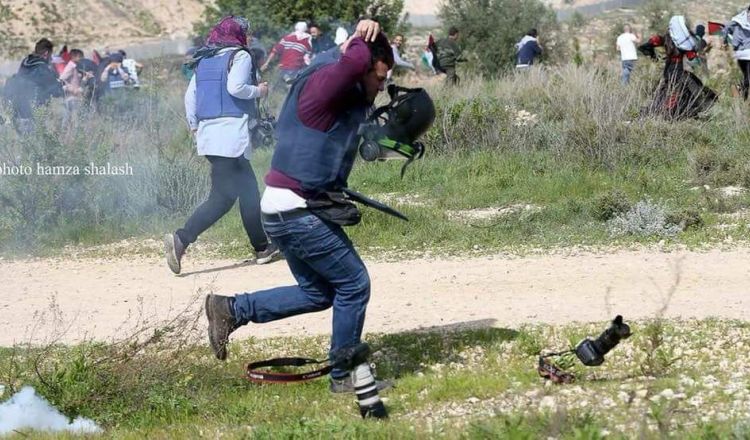More than 181 Violations against Journalists since the Start of "Great March of Return"
2018-07-05 11:08

More than 181 journalists have been injured since the launch of "Great March of Return"
The Journalist Support Committee: The high rate of injuries is a shock to all press freedoms observers
The Israeli occupation continues its aggression against the Palestinian journalists who have been covering the marches of return since March 30, while the international and human rights organizations turn a blind eye to Israeli occupation's aggressions against journalists which violate all international conventions and covenants guaranteeing the freedom and protection of Palestinian journalists during coverage.
The Journalist Support Committee issued a statement, on Wednesday morning, about the ongoing violations against Palestinian journalists on the border of the Gaza Strip describing it as "shocking" to all press freedom observers and watchdogs, pointing out that the international institutions' overlook of these attacks have encouraged the perpetrators to proceed with their arbitrary measures against the media.
The Committee noted that there has been a significant increase in the number of injured journalists covering the peaceful marches, where on Tuesday, July 3, 2018, the committee has monitored that a number of journalists were injured by live bullets, poison gas and suffocation during their coverage of the women's march of return in East Gaza, including journalist Thaer Abu Riash sustained a head injury with a tear gas canister, journalist Zaki Awadallah sustained a neck injury with a gas grenade, the journalist Mohammed al-Za'noun was also wounded by shrapnel in the shoulder shot by the Israeli occupation, and Amad media reporter Safinaz Al-Loud was also wounded by Israeli gunfire.
The Committee stated that the number of casualties since the beginning of the peaceful March of Return increased significantly, with the number of casualties by live bullets and shrapnel have reached 44, their injuries varied from moderate to dangerous and lethal where two journalists were killed: Yaser Murtaja and Ahmed Abu Hussein, in addition the amputation of the right leg of journalist Yousef al-Karnaz.
Forty journalists and media workers were deliberately hit by tear gas canister that targeted their bodies, causing burns, fractures and injuries.
While a large number of journalists, more than 110 cases, suffered from suffocation and fainting due to gas inhalation, many of whom were transferred to hospitals for treatment while others were treated in the field.
Four journalists were wounded by rubber-coated bullets, and six vehicles were targeted with gas grenades, destroying glass and damaging equipment and press attachments.
The Committee noted that 27 female journalists and media outlets had their share of the injuries, most of which fall under suffocation and fainting.
In light of this, the Committee called for the immediate intervention to provide protection to journalists and to work hard to find ways and means to prevent the targeting of journalists and to provide safe areas and gear during their field coverage.
The Committee also called upon Palestinian media and human rights organizations to unify action, under specific mechanisms, to demand that the Israeli occupation be punished internationally for its violations against Palestinian journalists and to put an end to impunity.
The Committee warned of the danger of deliberate targeting of journalists by the occupation, which poses a genuine threat to their lives, in addition, these violations prevent journalists from performing their professional duty in covering the confrontations and peaceful marches.
The Committee reiterates its call for the widest local, Arab and international campaign to expose the practices of the occupation against journalists and provide the elements of resilience and support for Palestinian journalists, especially that the majority of the Palestinian press crews do not have the most basic protective equipment such as flak jackets, helmets or armored vehicles.
Journalist Support Committee - Palestine
4 July 2018









